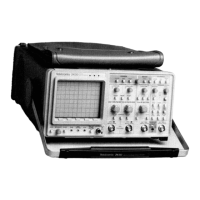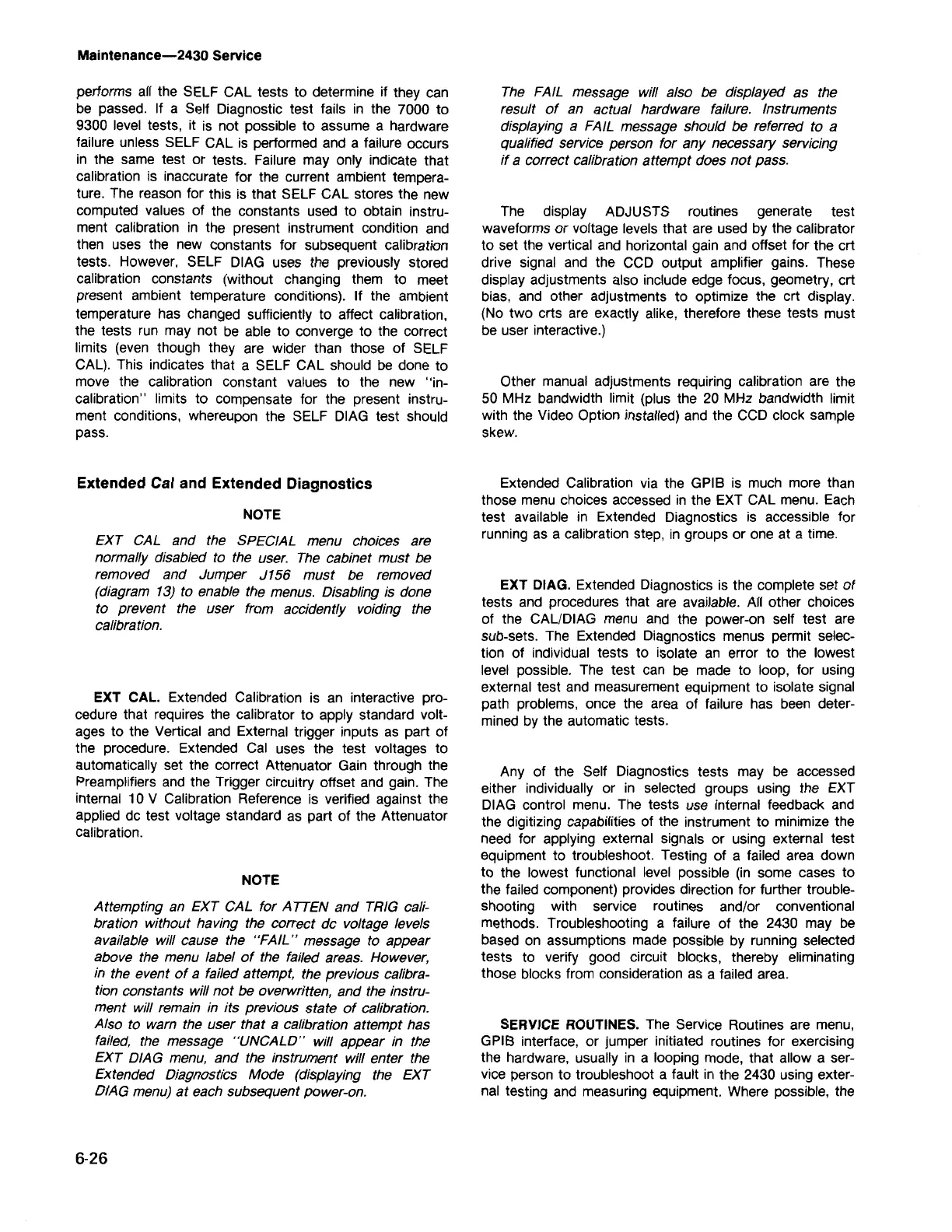SERVICE ROUTINES. The Service Routines are menu,
GPIB interface, or jumper initiated routines for exercising
the hardware, usually in a looping mode, that allow a ser-
vice person to troubleshoot a fault in the 2430 using exter-
nal testing and measuring equipment. Where possible, the
Any of the Self Diagnostics tests may be accessed
either individually or in selected groups using the EXT
DIAG control menu. The tests use internal feedback and
the digitizing capabilities of the instrument to minimize the
need for applying external signals or using external test
equipment to troubleshoot. Testing of a failed area down
to the lowest functional level possible (in some cases to
the failed component) provides direction for further trouble-
shooting with service routines and/or conventional
methods. Troubleshooting a failure of the 2430 may be
based on assumptions made possible by running selected
tests to verify good circuit blocks, thereby eliminating
those blocks from consideration as a failed area.
EXT DIAG. Extended Diagnostics is the complete set of
tests and procedures that are available. All other choices
of the CAUDIAG menu and the power-on self test are
sub-sets. The Extended Diagnostics menus permit selec-
tion of individual tests to isolate an error to the lowest
level possible. The test can be made to loop, for using
external test and measurement equipment to isolate signal
path problems, once the area of failure has been deter-
mined by the automatic tests.
Extended Calibration via the GPIB is much more than
those menu choices accessed in the EXT CAL menu. Each
test available in Extended Diagnostics is accessible for
running as a calibration step, in groups or one at a time.
Other manual adjustments requiring calibration are the
50 MHz bandwidth limit (plus the 20 MHz bandwidth limit
with the Video Option installed) and the CCD clock sample
skew.
The display ADJUSTS routines generate test
waveforms or voltage levels that are used by the calibrator
to set the vertical and horizontal gain and offset for the crt
drive signal and the CCD output amplifier gains. These
display adjustments also include edge focus, geometry, crt
bias, and other adjustments to optimize the crt display.
(No two crts are exactly alike, therefore these tests must
be user interactive.)
The FAIL message will also be displayed as the
result of an actual hardware failure. Instruments
displaying a FAIL message should be referred to a
qualified service person for any necessary servicing
if a correct calibration attempt does not pass.
6-26
NOTE
Attempting an EXT CAL for
A
TTEN and TRIG cali-
bration without having the correct dc voltage levels
available will cause the "FAIL" message to appear
above the menu label of the failed areas. However,
in the event of a failed attempt, the previous calibra-
tion constants will not be overwritten, and the instru-
ment will remain in its previous state of calibration.
Also to warn the user that a calibration attempt has
failed, the message "UNCALD" will appear in the
EXT DIAG menu, and the instrument will enter the
Extended Diagnostics Mode (displaying the EXT
DIAG menu) at each subsequent power-on.
EXT CAL. Extended Calibration is an interactive pro-
cedure that requires the calibrator to apply standard volt-
ages to the Vertical and External trigger inputs as part of
the procedure. Extended Cal uses the test voltages to
automatically set the correct Attenuator Gain through the
Preamplifiers and the Trigger circuitry offset and gain. The
internal 10 V Calibration Reference is verified against the
applied dc test voltage standard as part of the Attenuator
calibration.
Extended Cal and Extended Diagnostics
NOTE
EXT CAL and the SPECIAL menu choices are
normally disabled to the user. The cabinet must be
removed and Jumper J156 must be removed
(diagram 13) to enable the menus. Disabling is done
to prevent the user from accidently VOiding the
calibration.
performs all the SELF CAL tests to determine if they can
be passed. If a Self Diagnostic test fails in the 7000 to
9300 level tests, it is not possible to assume a hardware
failure unless SELF CAL is performed and a failure occurs
in the same test or tests. Failure may only indicate that
calibration is inaccurate for the current ambient tempera-
ture. The reason for this is that SELF CAL stores the new
computed values of the constants used to obtain instru-
ment calibration in the present instrument condition and
then uses the new constants for subsequent calibration
tests. However, SELF DIAG uses the previously stored
calibration constants (without changing them to meet
present ambient temperature conditions). If the ambient
temperature has changed sufficiently to affect calibration,
the tests run may not be able to converge to the correct
limits (even though they are wider than those of SELF
CAL). This indicates that a SELF CAL should be done to
move the calibration constant values to the new "in-
calibration" limits to compensate for the present instru-
ment conditions, whereupon the SELF DIAG test should
pass.
Maintenance-2430 Service

